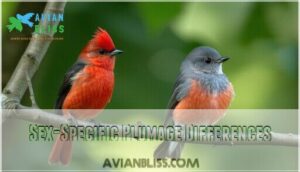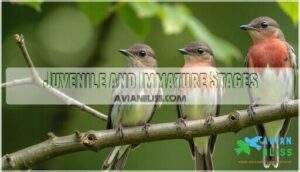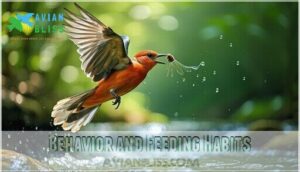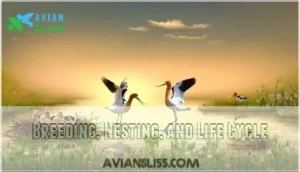This site is supported by our readers. We may earn a commission, at no cost to you, if you purchase through links.

Females trade the fire for subtlety—gray-brown bodies with salmon-pink bellies that blend into scrubland shadows. These flycatchers occupy an ideal niche where arid landscapes meet water, hunting insects from exposed perches across the southwestern United States into South America.
Their presence signals healthy riparian corridors, but habitat loss threatens the ecosystems they depend on.
Table Of Contents
- Key Takeaways
- Vermilion Flycatcher Identification and Appearance
- Habitat and Geographic Distribution
- Behavior and Feeding Habits
- Breeding, Nesting, and Life Cycle
- Conservation Status and Ecological Importance
- Frequently Asked Questions (FAQs)
- How rare are Vermilion Flycatchers?
- What does it mean to see a Vermilion Flycatcher?
- Where do Vermilion Flycatchers live?
- What is the difference between a scarlet tanager and a Vermilion Flycatcher?
- What are the vermilion flycatchers preferred habitats?
- Are vermilion flycatchers affected by climate change?
- Do vermilion flycatchers migrate seasonally?
- How do vermilion flycatchers catch their prey?
- What is the conservation status of vermilion flycatchers?
- What do vermilion flycatchers eat besides insects?
- Conclusion
Key Takeaways
- Vermilion flycatchers are easy to identify by their vivid red male plumage and the subtle salmon-pink bellies of females, showing clear differences between sexes and ages.
- These birds thrive where arid scrublands meet water, especially in riparian habitats across the southwestern United States into South America, but habitat loss threatens their survival.
- Vermilion flycatchers hunt insects with agile aerial techniques from exposed perches, and their presence signals a healthy ecosystem with plenty of insect life.
- Although listed as Least Concern, regional declines and island extinctions highlight the need for habitat preservation and ongoing conservation efforts.
Vermilion Flycatcher Identification and Appearance
You can identify a Vermilion Flycatcher by learning to spot key differences between males, females, and young birds.
The species shows dramatic variation in appearance based on sex and age, which helps you confirm what you’re seeing in the field.
Here’s what to look for when identifying this distinctive flycatcher.
Sex-Specific Plumage Differences
You’ll notice right away that male and female Vermilion Flycatchers don’t look much alike—it’s one of the most dramatic differences you’ll see in North American songbirds. Adult males display vivid red crowns and underparts paired with dark brown backs—this striking male coloration results from sexual selection.
Adult females show subtle gray-brown plumage with warm salmon-red blushes on their bellies. This sexual dimorphism becomes evident as immature males and immature females develop their distinctive adult plumage through plumage ontogeny.
Juvenile and Immature Stages
If you’re tracking a young Vermilion Flycatcher through its first year, you’ll watch it progress through several distinct plumage stages before it resembles either parent. Juveniles show brown upperparts with heavily streaked bellies, making bird identification challenging during post-fledging weeks.
Immature females develop peachy blushes on their bellies with streaky breasts, while immature males begin showing reddish tones that hint at future brilliance.
This plumage development aids parental recognition and reflects the species’ pronounced sexual dimorphism emerging gradually over months.
Size, Shape, and Distinctive Features
Once you’ve sorted out age and plumage, you’ll want to get a feel for the bird’s physical build—Vermilion Flycatchers are compact, measuring 13–14 cm in length with a wingspan of 24–25 cm and weighing just 11–14 grams. Their short tail and slight crest give them a distinctive profile during bird identification.
Males show striking plumage brightness in red, while sexual dimorphism becomes obvious in the female’s subdued tones—key species characteristics you won’t miss in the field.
Habitat and Geographic Distribution
You’ll find Vermilion Flycatchers in a surprising range of places across the Americas. Their habitat preferences tell you a lot about where to search for these vividly red birds. Let’s look at the specific environments and regions where they make their home.
Preferred Habitats and Ecosystems
You’ll find Vermilion Flycatchers in sun-baked landscapes where water and insects meet—open scrublands, desert washes, agricultural edges, and riparian woodlands become their hunting grounds. Despite their arid adaptations, riparian dependence links them to water proximity for foraging success.
Habitat fragmentation threatens these riparian ecosystems, yet the Vermilion Flycatcher habitat remains essential to their ecosystem role as insectivorous predators across desert and arid habitats throughout their distribution.
Range in North, Central, and South America
Across the Americas, Vermilion Flycatchers span a Continental Distribution from the southwestern United States through Central America into South America. Regional Abundance peaks in Texas, California, and the Southwest, where Migration Patterns reveal both resident and short-distance migratory populations.
Habitat Variation drives their presence—riparian corridors in arid zones support higher densities, while Range Expansion remains limited by water-dependent foraging needs and climate-driven habitat shifts across their geographic range. These birds are commonly found near desert habitats.
Adaptation to Arid and Riparian Environments
In desert scrublands and along waterways, Vermilion Flycatchers have evolved specialized adaptations that let them thrive where water is scarce and temperatures soar. Their habitat selection centers on riparian zones in the Sonoran Desert and Chihuahuan Desert, where insect availability peaks near arroyos and canyons.
Nesting proximity to water aids temperature regulation during breeding, while their water dependence remains minimal—you’ll find them hunting exposed perches where riparian habitat meets arid scrub.
Behavior and Feeding Habits
When you’re watching a Vermilion Flycatcher, you’ll notice it has a distinctive style of hunting and moving through its territory.
These birds rely on specific foraging strategies and show off with impressive aerial displays. Let’s look at how they feed, perch, and move with the seasons.
Foraging Techniques and Diet
Vermilion Flycatchers hunt like patient snipers, watching from low perches before launching sudden aerial strikes on their insect prey. Their feeding habits showcase striking foraging efficiency through several insectivorous bird techniques:
- Insect Hawking – Capturing flying insects mid-flight with acrobatic precision
- Hovering Tactics – Suspending in air before dropping to ground-based prey
- Prey Selection – Targeting beetles, flies, grasshoppers, and other invertebrates
- Diet Variation – Adjusting feeding behavior seasonally based on insect availability
You’ll notice their diet and foraging success depends entirely on insect-rich environments.
Perching and Flight Displays
When a male Vermilion Flycatcher isn’t hunting, he’s putting on one of the bird world’s most eye-catching aerial shows—fluttering high above his territory like a wind-up toy while belting out his tinkling song. This display has double duty: attracting females and warning rival males away.
You’ll spot these behavioral traits from their favorite low perches, where they scan for both insects and intruders before launching into another mating flight performance.
Seasonal Movements and Migration Patterns
Unlike many songbirds that follow strict avian migration patterns, most Vermilion Flycatchers stay put year-round in their southwestern territories—though some northern breeders do drift south when temperatures drop. Here’s what drives their seasonal movements:
- Migration Triggers: Cold snaps and dwindling insect populations push northern populations toward Mexico
- Altitudinal Migration: Mountain residents descend to warmer valleys during winter months
- Vagrancy Patterns: Occasional wanderers show up along the Gulf Coast or even farther east
The species’ breeding range extends into south Texas. Breeding dispersal happens locally, with juveniles rarely traveling far from their natal areas.
Breeding, Nesting, and Life Cycle
When you watch a male Vermilion Flycatcher perform his sky-dancing courtship routine, you’re witnessing the start of a carefully orchestrated breeding cycle.
From nest construction to the moment young birds leave home, each stage follows a predictable pattern shaped by the species’ desert and riparian lifestyle. Here’s how these striking flycatchers raise their offspring.
Courtship and Mating Displays
You’ll spot a male Vermilion Flycatcher’s courtship routine long before you hear it—a vivid red bird rising high into the air with rapid, butterfly-like wingbeats while delivering a spirited twittering song that echoes across his territory.
This flight-song display has dual purposes in avian behavior: attracting potential mates while reinforcing territory defense against rival males. The display’s intensity and frequency often correlate with breeding success, as females assess male fitness through these aerial performances before mate selection occurs.
Nest Construction and Placement
Once the female accepts a mate, she takes sole responsibility for building a compact cup-shaped nest in a horizontal tree fork, usually positioned 8 to 20 feet above ground in an open, visible location. She gathers nest materials including twigs, grass, weeds, and spider webs to form the outer structure, then lines the interior with finer plant fibers, hair, and feathers.
Site selection consistently favors horizontal branches in open areas near water sources—habitat features that aid both territory monitoring and foraging access during the nesting and breeding period.
Incubation, Fledging, and Parental Care
After construction wraps up, the female settles in to incubate her clutch of 2 to 4 eggs for 13 to 15 days, undertaking this task entirely on her own while the male defends the territory and occasionally brings her food. Once hatching success occurs, both parents shift into active feeding roles, delivering insects to nestlings throughout the 14 to 16-day fledging period.
Key aspects of nesting and incubation:
- Egg development progresses without male assistance during the two-week incubation phase
- Nestling diet consists exclusively of insects captured through aerial hawking and hover-gleaning
- Parental roles divide clearly: females brood young initially while males increase food delivery
- Brood defense intensifies as fledging approaches, with both adults aggressively protecting the nest site
You’ll often see pairs raise one to two broods per breeding season, reflecting their adaptable nesting and breeding behavior and ecology in insect-rich riparian habitats.
Conservation Status and Ecological Importance
The Vermilion Flycatcher faces shifting challenges across its range, from habitat loss to declining insect populations. Understanding these pressures helps us see where conservation efforts matter most.
Let’s look at the current status, what’s being done to protect them, and why these striking birds play a bigger role in their ecosystems than you might expect.
Population Trends and Threats
Though the global population sits around 2,000,000 individuals, you’ll find troubling signs beneath the surface. Texas population decline has been documented in recent surveys, while Climate change impacts and Habitat loss effects continue threatening southwestern populations. Insecticide use reduces prey availability in agricultural areas.
Island extinctions paint the darkest picture—San Cristóbal’s endemic subspecies vanished by 2023, and fewer than 40 birds survive on Santa Cruz with ongoing reproductive failure.
San Cristóbal’s endemic Vermilion Flycatcher vanished by 2023, with fewer than 40 birds now surviving on Santa Cruz Island
Despite its IUCN Status of Least Concern, overall numbers are decreasing across Habitat and Distribution ranges, signaling need for Wildlife Conservation attention.
Conservation Efforts and Habitat Preservation
Targeted conservation efforts now focus on habitat preservation along southwestern riparian corridors, where protected areas safeguard critical breeding grounds.
Population monitoring programs track declines through citizen science networks, while habitat restoration projects replant native vegetation in degraded zones. Pesticide reduction campaigns near waterways help maintain insect prey abundance.
Climate impacts demand adaptive wildlife conservation strategies, particularly for island subspecies facing immediate extinction risk.
Role in Ecosystem and Biodiversity
As a predator of flying insects, the Vermilion Flycatcher plays a measurable role in controlling arthropod populations within its arid and riparian habitats.
You’ll find this species acts as an indicator of ecosystem health, reflecting insect population control effectiveness and overall avian biodiversity. Their presence aids food web dynamics and seed dispersal, contributing to species preservation and ecosystem conservation efforts across multiple habitats.
Frequently Asked Questions (FAQs)
How rare are Vermilion Flycatchers?
Vermilion Flycatchers aren’t particularly rare across their range, with roughly 2,000,000 individuals worldwide. However, regional declines in Texas and local extinctions—like San Cristóbal Island’s population—signal concerning habitat loss trends in certain areas.
What does it mean to see a Vermilion Flycatcher?
Seeing a Vermilion Flycatcher in the American Southwest often carries symbolism related to vitality and beauty for wildlife enthusiasts. Personal encounters during bird watching provide memorable birding experiences, though spiritual significance varies by cultural interpretations.
Where do Vermilion Flycatchers live?
These striking birds inhabit the Southwestern United States, Mexico, and riparian habitats throughout Central and South America.
You’ll find them in arid scrublands, savannahs, and farmlands near water sources, displaying considerable habitat diversity and regional variations.
What is the difference between a scarlet tanager and a Vermilion Flycatcher?
You’ll notice the adult male Scarlet Tanager has an all-red body with black wings, while the adult male Vermilion Flycatcher shows a red crown and underparts with a brown back.
Size differences and habitat overlap also help with wildlife identification.
What are the vermilion flycatchers preferred habitats?
You’ll find these birds in open country with scattered trees and shrubs, especially near water sources. They also inhabit arid scrublands, savannas, grasslands, and lightly cultivated farmlands across their range.
Riparian zones along streams support high insect abundance.
Are vermilion flycatchers affected by climate change?
Climate change poses significant threats through habitat shifts and insect decline. You’ll see breeding impacts from extreme weather events affecting nesting success.
Range changes are occurring as temperatures rise, particularly impacting migratory patterns and water-dependent riparian zones these flycatchers inhabit.
Do vermilion flycatchers migrate seasonally?
Migratory patterns vary across populations of this species. Northern breeding birds usually move south for winter, while southern populations often remain year-round as resident birds. Some individuals show altitudinal migration in mountainous regions.
How do vermilion flycatchers catch their prey?
Scanning open spaces, aerial insectivores like these master the Hawking Technique—darting from chosen perches, snatching insects midair, and sometimes hovering briefly.
Diet composition centers on flying prey, making their perching and hovering behavior essential for survival.
What is the conservation status of vermilion flycatchers?
You’ll find the Conservation Status for this bird species listed as Least Concern on the IUCN Red List. Still, population decline from habitat loss and climate impacts means ongoing conservation efforts and wildlife habitat preservation remain essential.
What do vermilion flycatchers eat besides insects?
Imagine a bird adjusting its menu with the seasons—besides insects, alternative food sources like berries may supplement their diet.
Dietary adaptations help meet nutritional needs when prey availability dips, especially in riparian habitats or shifting ecological roles.
Conclusion
Imagine a flash of scarlet against muted desert earth—the vermilion flycatcher stands out, yet its survival depends on fading riparian corridors. Observing its behavior gives you insight into the delicate balance of arid habitats.
This bird’s vibrant plumage and subtle hunting patterns tell two stories: one of visual brilliance, another of ecological fragility. Protecting these landscapes isn’t just about saving a species; it’s about preserving the intricate web that sustains life and color in unlikely places.










